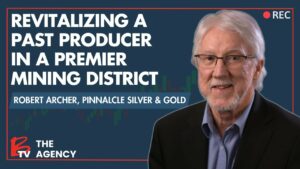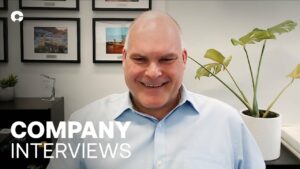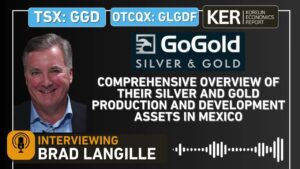Executives
Carlos Baca – IR
Jorge Alberto Ganoza – President and CEO
Luis Dario Ganoza – Chief Financial Officer
Analysts
Nicholas Campbell – Canaccord Genuity
Chris Thompson – Raymond James
Chris Lichtenheldt – Dundee Capital Markets
George Shea – Cicada Investments
Fortuna Silver Mines Inc. (FSM) Q3 2013 Earnings Conference Call November 6, 2013 12:00 PM ET
Operator
Greetings and welcome to the Fortuna Silver Mines’ Third Quarter 2013 Earnings Conference Call. At this time, all participants are in a listen-only mode. A brief question-and-answer session will follow the formal presentation. (Operator Instructions). As a reminder, this conference is being recorded.
It is now my pleasure to introduce your host, Carlos Baca. Please go ahead Mr. Baca.
Carlos Baca – IRThank you, operator. Good morning, ladies and gentlemen. I would like to welcome you all to Fortuna Silver Mines and to our third quarter financial and operations result call. Jorge Alberto Ganoza, President and CEO and Luis Dario Ganoza, Chief Financial Officer will be hosting the call from Lima, Peru.
Before I turn over the call to Jorge, I would like to indicate that certain information contained or incorporated by reference in this earnings call including any information as to our strategy, projects, plans or future financial or operating performance constitutes forward-looking statements. All statements other than statements of historical facts are forward-looking statements, the words, believes, expect, anticipate, contemplate, target, plan, intend, continue, budget, estimate, will, schedule and similar expressions identify forward-looking statements.
Forward-looking statements are necessarily based upon a number of estimates and assumptions that while continued reasonable by the company are inherently subject to significant business, economic and competitive uncertainties and contingencies. Known and unknown factors could cause actual results to differ materially from those projected in the forward-looking statements. We disclaim any intention or obligation to update or revise any forward-looking statements whether as a result of new information, future events or otherwise, except as required by applicable law.
I would now like to turn the call over to Mr. Jorge Ganoza, President, CEO and Co-Founder of Fortuna. Thank you once again to everyone for joining us.
Jorge Alberto Ganoza – President and CEOThank you, Carlos, and good morning to all. I am joined on the call today by Luis Ganoza, our CFO. I will initiate the conference call and with assistance of Luis we will be giving a summary and analysis of our operations and financial results for the third quarter of the year. Once concluded, we will address your questions.
We have two significant milestones for the company which have taken place in the third quarter and this past month of October. First in September we announced the successful commissioning of the expansion of our San Jose mine and mill, an increase of 60% in throughput capacity growing from our 1,000 tons per day to 1,800 tons per day. And second on October 17th, we announced an update resource and reserve estimation for San Jose reporting an increase of 22% in silver reserves and 39% in silver inferred resources. The jump in inferred resources come at a higher grade and its attributable to the early inclusion of drill result from the Trinidad North Discovery with only six months of drilling prior to the resource estimation cross date of July 4.
The high grades in Trinidad North zone remains wide open to the north. And today we are currently drilling exploring the extension from underground with one rig and will be including a second one this month. For silver and gold production year-to-date is in line to meet annual guidance of 4.5 million ounces of silver and 23,600 ounces of gold or 5.9 million silver equivalent ounces. Silver produced in the quarter was 1.1 million ounces and 4,500 gold ounces. Compared to Q3, 2012, silver is up by 8% and gold is down by 16%.
For Caylloma mine, performance in terms of mills throughput and grade are in line with our budget and the comparable quarter. And silver output is 6% above year-to-date guidance. Something to highlight is silver recoveries are up to 84% against recoveries of 78% in our budget and 76% in comparable quarter. We believe we can sustain and have opportunities to continue improving on silver recoveries at Caylloma.
At our San Jose mine, mill throughput for the quarter was down 8% against budget due to unscheduled stocks related to the commissioning of the expansion. Silver grade was slightly below budget at 2%, but gold grade was down by 15% against budget. The combination of less throughput and lower grade resulted in a 10% drop in silver and 22% drop in gold production for the quarter.
For the commissioning of the expansion behind this, we plan to see a stronger quarter at San Jose in Q4 and onwards. We attributed dropping gold rate to local rate variations within our model and production plans. Long term resource grade to production continuation at San Jose is acceptable.
Silver accounted for 64% of sales in the period, gold 12% of sales, lead 11% of sales and zinc 12% of sales.
Moving on, capita reductions and cost cutting measures implemented at the mine and corporate in mid year have been successfully implemented with beatable results this quarter. At Caylloma cost per ton is down by 7% from $95 to $87 per ton in-line with our target reverting several quarters of cost encrypts. At San Jose, cost per ton was 7% higher than budget at $72, mainly impacted by 8% less throughput in the period related to the commissioning of the expansion. We expect to feel the benefit of a higher throughput capacity starting in Q4 with higher metal output and lower costs. So we reaffirm cost and production guidance from this mine for the year.
On an all-in cost basis Caylloma was also in line with budget and guidance with about $21 per ounce versus 2013 guidance of $20.80 per ounce. At San Jose, year-to-date all-in cost was $23.80 against $19 projected for the year. Once again we expect to see all-in costs coming down in Q4 as a commissioning is behind and we benefit from higher metal output.
For the period 2014 through 2016, we have guided to lower all-in costs of $12 and $11 at San Jose and Caylloma respectively. This reflects the mines at steady state levels of 1,800 tons per day and 1,300 tons per day.
In light of the Trinidad North Discovery we are assessing opportunities to increase throughput in the near future. We will be reporting on these initiatives as exploration progresses in these new zones.
Silver price for the quarter was $21.30 per ounce and gold $1,327 per ounce.
At the end of the quarter we reported our cash position of $42 million. The companies adequately funded to meet its capital requirements from cash at hand and cash flow generation.
I will now let Luis take you through the financial statements.
Luis Dario Ganoza – Chief Financial OfficerThank you Jorge. We recorded a net loss for the period of $0.3 million, and income before tax of $2.2 million. So just to emphasize that, we actually recorded income before taxes but nonetheless recorded a net loss. The reason for this was mostly the high effective tax rate at our operating subsidiaries resulting in an income tax provision of $2.5 million which gets us into a loss for the quarter.
Our income before taxes in the period decreased by $10.1 million when compared to Q3 of 2012, where this decrease is explained mainly by lower realized silver and gold prices of 29% and 21% respectively.
Our sales decreased by 31% as a result mostly of lower prices and to a lesser extend as a result of lower gold sold against the comparable period of 25%. The latter is in turn explained by lower gold production and a slight accumulation of inventory in Q3 of 2012.
Our mine operating income decreased by 58% driven by the drop in sales, this mainly the effect of sales was partially offset by improved cost performance at San Jose when compared to the previous year. Unit costs came down by 11% at San Jose. And the Caylloma, the significant improvement in silver recoveries also held and partially offsetting the affect of lower prices. Our operating income for the quarter was 81% below Q3 2012. However, here we also had a positive factor helping us offset partially the lower sales. Our total selling, general and administrative expenses were $1.8 million lower than 2012. Around half of this reduction is explained by our cost cutting measures, the other half is related to lower stock-based compensation.
In terms of our income tax, as described before our effective tax rate for the quarter was particularly high and unusual in the sense that it was above 100%. On a quarterly basis the effective tax rate can be quite volatile, it is better to look at the year-to-date rates to get a better sense of what is going on. And to make sense of our year-to-date effective tax rate however we have to strip out the effect of the $50 million impairment recorded in Q2 back then we disclosed related impact on deferred taxes of $4.8 million. So considering this to P&L the effect of impairment, our year-to-date effective tax rate is around 55%. It is high with respect to the 40% to 45% we would usually expect to see and this explained by the devaluation of the Peruvian sol against the dollar that we have seen throughout the year. This has had an impact on both our incurred current tax and the deferred tax calculation that shows up in our income statement.
Moving down to the cash flow statement. Net cash provided by operating activities for the nine months ended September 30 was $28.2 million and cash consumed in capital expenditures that is property, plant and equipment was $51.3 million, including the $10 million acquisition of the Taviche Oeste concession. This corresponds to a net consumption of cash of around $23 million which explains the decrease in our cash position throughout 2013, which considering short term investments went from $64.7 million at the beginning of the year to $42.7 million at the end of September.
Jorge Alberto Ganoza – President and CEOThank you.
Carlos Baca – IR
Thank you very much for listening in. We would now like to turn the call over to any questions that you may have. Operator we are ready to take questions.
Question-and-Answer Session
Operator
Thank you. We will now be conducting a Question-and-Answer Session. (Operator Instructions) Our first question comes from Nicholas Campbell from Canaccord Genuity. – Canaccord Genuity
Nicholas Campbell – Canaccord GenuityHey, guys. Just wondering if you can give us a little bit of an indication of how the grade schedule is going at both mines in Q4 and whether or not we should expect to see any sort of deviations from the most recent mine plan from 2014 onwards?
Jorge Alberto Ganoza – President and CEOOkay. Nick, I assume you are asking particularly about gold rates at San Jose. As I stated Caylloma is meeting guidance. But we have identified the San Jose is a bit of annoyed effect which we have not singled out before is to be expected due to the nature of gold. We believe it is in our plans to achieve guidance, in fact we are starting to see in the month of October gold better in line with what we project for the month. We have taken several measures to help us mitigate the liability we are seeing in gold on the short term basis. And I like to stress that we have looked deep reconciliation of our resource, reserve production models to production. And reconciliation is quite good within 10% which for models like these would be acceptable. And we attribute these to changes to local variations within production sound, so where the mine is transiting at a given point.
So I can report that in this fourth quarter we are seeing gold closely aligned with 1.6 grams that we forecast for the period in our plan, a little bit of background in the first quarter this year. We saw gold deviating down 9% from our plan. In the second quarter gold was in-line with our plan and this third quarter we had seen gold off 15% in terms of grade as I stated.
We do expect we will trend towards to be within 10% which is reasonably to be expected.
Nicholas Campbell – Canaccord GenuityOkay. And you mentioned that you are also assessing on an ongoing basis the potential to further expand the San Jose mine depending on the results at Trinidad North. Can you give us an idea about how, what the limitations are? I understand there are some limitations in terms of water availability in the area and just how is that all going to fit in with the potential expansion?
Jorge Alberto Ganoza – President and CEOYes. Well not see any bottlenecks in the plant, the plant can be easily expandable. We do not see any bottlenecks on the mine. As it is designed today it could be scalable significantly, we have enough power. And water has always been the issue we deal with at this mine. We currently are – the mine was originally designed for 1,000, we developed water sources for a 1,000. Then we designed an expansion to 1,500, we were able to develop sources for 1,500. We went up to 1,800. We’ve been able to develop water sources that are now good up to 2,000 tons per day. Our water balance is met for up to 2,000 tons per day. And we’re currently in the process of implementing additional solutions particularly on the matter of operation control. Our immediate water opportunity is around of operation control. As you know Nick, we store water in our tailings dam, which is a large water reservoir and where we are subject to very high amounts of operation as a result of the large surface area of the farm.
So we are in the process of implementing our solution. And if we can control as much as 80%, 90% of operation and thats still to be seen as we’re implementing the solution. The manufacturer claims, we can achieve 90% control. We could have a substantial amount of water available. What were saying is that we need 2014 exploration to progress for us to have a better handle on the kind of throughput that we should be modeling for an increase. And also to look at more realistic water balance not just the theoretical water balance based on evaporation control measure that were implementing. And bringing those two together, they come up with a plan for an expansion.
Additional to the evaporation control, we are looking at potentially new sources of water. As you know we already source water from sewage plant, which is actually (inaudible) its been done, it had the great social environmental impact in the area. And there is a second town in the vicinity, where we already have some preliminary discussions and some scope in level of engineering regarding the implementation of Ocotlán sewage plant to draw water from that processing of sewage like we already do. So we have alternatives at hand. We are also looking to implement, migrate from conventional handling of things to haste that would also be an opportunity to get wider level from the tailings.
So we have opportunities at hand to think about higher throughputs than the current 2,000 tons per day that we have in our water balance today. So we just need a little time in order to be able to put all of these ideas and initiatives in paper backed by engineering.
Nicholas Campbell – Canaccord GenuityOkay. Just one more question and I will let somebody else ask one. The realized prices that you guys had this quarter were pretty low. I assume some of that just has to do with the concentrated the terms in your selling. How much of it had to do with re-pricing of provisional pricing in a declining price environment?
Luis Ganoza
I think you are referring, Nick to the net realized prices we report and these are all really reported based on provisional sales. So they would not include negative adjustments nor positive adjustments from the price or other factors. We did experience a bit of low grade concentrated production at San Jose which affects commercial terms. And that would really be the only driver impacting net realized prices as compared to what we have been reporting in the past and the realized prices we report as well.
Nicholas Campbell – Canaccord GenuityAnd is that related to the low grade in the quarter or is that something thats going to happen on a regular basis?
Luis Ganoza
No, no it really had to do with a particular event to a quarter. Moving forward in terms of our net realized prices on silver, so as you know considering the actual payable metal and refining charges, our net realized price is around 92% of the actual average prices that we are getting in the market for the quarter. So thats what we should expect going forward.
Nicholas Campbell – Canaccord GenuityOkay. Thanks a lot, guys.
Operator
Thank you. Our next question comes from Chris Thompson from Raymond James.
Chris Thompson – Raymond JamesHi. Good morning, guys. Congratulations on the good quarter. Two quick questions one on the San Jose. I understand obviously that were going to be, youre underground drilling I guess two rigs soon to test the underground potential of the discovery there. At what point would you need if at all to get access, surface access to fill the in-fill drilling of discoveries there?
Jorge Albreto Ganoza
Right now we are in a position to carry the exploration of immediate discovery. We are expecting out as much as 250 and 300 meters via underground access. Now all of the Northern extent for the projection of Trinidad North to the North discovered under (inaudible) so there is no output. The only hint of continuity is a small [outlook] located two kilometers away of basically [Trinidad] North expands as a small window within the small island within the (inaudible) thats two kilometers.
We intend to test as much of the Northern extent and just for reference we can start talking about the coverage of this initial two kilometers. To correlate two kilometer extent in any effective manner, we of course would need surface access. The surface property lies within the community of Magdalena. The community of Magdalena is a community with which we have had previous successful negotiations. There has been an election in Magdalena. There is a new municipal and — in place. And they are taking office in January.
We have some early discussions with the new elected officials. They are receptive to the idea of granting us permit to access the surface. And we are just waiting for January for them to take office. So we can engage in a negotiation with them and discussion.
In the meantime, all the work that we have to do we can carry from the underground which is an immediate step out from the discovery in an area of 200 meters, 300 meters. With existing infrastructure now we can continue driving that to the North with underground development. To take kilometer away, 100 meters away, 2 kilometers away, of course we would like to do rule that in 2014.
And although I wouldn’t commit to give dates regarding when we can get a permit, because you guys must know [Oaxaca] is challenging. I do believe that based on previous history, we will be successful in achieving those permits with this particular commitment.
Chris Thompson – Raymond JamesOkay. I understood. Thanks for that. Just one more question I guess on the cost per ton mill that Caylloma, I mean not see the cost coming down there, so $87 per ton mill is that sort of cost sustainable at that sort of level into the near-term. What should we be modeling that you think?
Luis Ganoza
We believe the costs are sustainable. We have gone through the process of optimizing the mine, optimizing the development, optimizing the amount of development and preparation charge to cost to take it steady 1,300 tons per day. And that is one large source of savings and other one was reduction in headcount at this operation of roughly 9% and 8%. So the short answer is yes we believe its sustainable.
Chris Thompson – Raymond JamesPerfect. Thank you very much.
Operator
Thank you. Our next question comes from Chris Lichtenheldt from Dundee Capital.
Chris Lichtenheldt – Dundee Capital MarketsGood morning everyone. Just a question on Trinidad North. When you presented the initial (inaudible) you presented a number of call operate scenarios. Can you talk a little bit about your abilities to or based on your early understanding of the discovery, can you discuss your abilities to mine at a higher cut-off of 150 plus further to provide a real sweetness, are there being higher grade and then concerns to the are those lower grade [wins] you had outlined in order to sustain the higher (inaudible)?
Jorge Albreto Ganoza
Yes. Thats a good question, let me elaborate. We did highlight in the release resources at our cut-off of 70 grams because that’s in line what we’ve been introducing in demand deposits, but we did provide a range of cut-off. And there are two ways for you what you can get a sense of what is that we can achieve here. One is just graphically you can go into our sections in the website and the look at and presentation and look at the grade countering and thickness countering of a grade and thickness. What you will see is a very consistent clustering of high grade, the strong purples and red in the countering — brought.
So that’s just one physical first class view of how the high grades are deteriorated. And the second one is if you move the cut-off from 70 grams and 70 grams what we record is 1.8 million tons at a silver equivalent grade of 360 grams for 60 million ounces of silver contained. If we move cut-off to 150 grams, we only lose roughly 400,000 tons in term of tonnage, tonnage rose to 1.3 to 1.4 million tons. But grade jumps from 350 to 460 grams and total ounces go from 16 million to 15 million.
So we only lose 1 million ounces. So what this indicates is that what we are losing when we move the cut-off in the periphery of the resource. We are currently running durations even though this is an inferred resource and we treated as such were internally running durations to see at a higher cut-off what happens when you see that we start getting that spotted [dark] pattern where you see the higher grade dispersing.
And what would be sensible to view this as a mining opportunity at what cut-off it would be sensible to see this as an opportunity for high grade because what we are saying is that short-term how do we benefit from the discovery. What we are saying is we have here the opportunity by early 2015 to start sourcing all from Trinidad North. This discovery so close to existing infrastructure that we could be in a position to have this area mine accessible the area of inferred resource mine accessible by 2015.
So we are in a position to start sourcing rock from that zone in 2015. So if we can source higher grade rock than what we are currently mining in the upper levels we can replace we believe initially potentially as much as 30% of throughput from these lower zone and have an impact on grade on overall grade that should lead to increased metal output.
Again the inferred resource at Trinidad North we currently have an inferred resource we are going to in parallel or concurrent with the exploration further to the North that I just spoke about. We are going to be infilling Trinidad North through 2014 thats part of our budget already for 2014 with area that we can have our measured indicated and reserves through the year so we can include it in our mine plan by early 2015 and the objective, the target will be to achieve higher grades. And we believe that by playing around with the cut-offs and the distribution of grades at the inferred level you see the consistency to support area of being able to mine at higher cut-offs. I couldnt be in a position right now to tell you that it will be 150 grams, and 175 and 125, but I can tell you that we can presumably see an opportunity for that.
Chris Lichtenheldt – Dundee Capital MarketsOkay, great. So quick follow up on that, if you look at the exploration you are doing now, do you think maybe by mid 2014 you have a more –?
Jorge Albreto Ganoza
The ideas is that we start drilling do in-fill drilling in the first half of the year we advance with inter drilling the first half of the year. We do our resources usually with our current date and if there is some particular sequence practice we use of current date of late June or early July with the purpose of having reserves for the third quarter. So I would expect by third quarter 2014, we have some, were in a position to leave production rates from our engineering work.
Chris Lichtenheldt – Dundee Capital MarketsOkay. Thats great. And I just have one question and Ill follow-up with respect to the earlier comments on realized pricing in the quarter. You said 90% to 92% availability on silver going forward, does that include, is that just a payable level and there are further treatment in finding deductions is that sort of your all-in payable?
Luis Ganoza
No, just to be 100% clear on that, we report the realized silver price, but we referred to the realized silver price which is very much in line with what most companies have their report. And it’s basically the average price other than markets as you realize based on the timing of your sales. We also report what we refer to as net realized price, which is the price after refining charges and considering the actual payable net off out of total net off in concentrate and premium charges of course. So I did say 90% to 91% that’s net realized price for silver based on current commercial terms and that’s the range we would expect going forward, yes.
Chris Lichtenheldt – Dundee Capital MarketsOkay, that’s perfect. Thanks a lot.
Operator
Our next question comes from George Shea from Cicada.
George Shea – Cicada InvestmentsSome of the press have discussed a new tax in Mexico, the upper house of Congress is said to have approved the proposal by the government of Enrique Nieto. Does this change any of your plans or do you have to have contingency plans to deal with the possible increase in tax?
Jorge Albreto Ganoza
Regarding to what this tax means to our long-term strategy more than the short term, we continue to be new Mexico, some mining reduction, where we can look forward to grow our business. More taxes just put a higher bar on the quality of projects we look at. We believe that San Jose is a mine and deposit on a deposit that are both robust enough to still perform quite well under the new tax regime. And again moving forward, we continue looking at Mexico favorably for the development of our mining business. On a relatively basis for our business really no jurisdiction is getting easier. So on relative terms, Mexico continues to be a place we look with good eyes.
George Shea – Cicada InvestmentsThank you. Are you finding any other opportunities in say Canada or Peru or other jurisdictions that you want to discuss?
Jorge Albreto Ganoza
Well, I can say that we are actively looking for growth opportunities. The Trinidad North discovery clearly provides for company the best growth opportunity and cheapest ounces we can bring to our inventories and to our future production. Our discovery cost per ounce on Trinidad North is negligible, cents per ounce even including the acquisition cost, the $10 million acquisition cost of the concession we paid this year. So the cost per ounce here is going to be measured in cents. I dont believe there are other places out there where we can acquire those, the quality of ounces on that price. So we will aggressively continue pursuing organic growth now that we have the tiger by the tail of Trinidad.
Having said that, we are always looking for good opportunities. We are better suited than before to move faster if we need to when we identify an opportunity and were looking mainly in Mexico, mainly in Peru, mainly throughout Latin America trying to stay within the times on always know.
George Shea – Cicada InvestmentsThank you very much.
Operator
Our next question comes from [Andy Schopick], who is a Private Investor.
Unidentified Analyst
I have two questions. First, I would like to direct the finance related question on taxes to Luis. Is there anything you are doing to try to mitigate this high volatility in your tax provisions, which is largely unpredictable from quarter-to-quarter? Are you doing anything to perhaps hedge the situation vis-à-vis the Peruvian solve or is there anything else that could be done to mitigate this?
Luis Dario Ganoza – Chief Financial OfficerNo, the answer is really no. I mean as higher the effect of the exchange rate on the income tax provision, there is a component that has to do with the deferred tax which is I would say for all practical purposes of irrelevant. There is a component of course that has to with the actual current taxes and in the case of our operations it tends from the cash balances we carry locally in U.S. dollars. And that effect is real of course. Local devaluation of a currency will increase our current taxes, yes, due to those cash balances in foreign currency held at our subsidiaries.
That is something that is manageable more from the side of currency which wed like to hold though in treasury. It wouldnt make it much sense to really conduct any large shift in terms of those surpluses we hold locally again and really the devaluation we are seeing even though it hit us on the side of income taxes, it has a positive effect on real cost right.
So we in general terms today do not have a national policy in place with respect to hedging foreign exchange effect. We would look on a yearly basis at our cash generation requirements based on capital expenditure commitment and based on that would look at opportunities in terms of securing the minimum cash requirements. If we deemed that foreign exchange presented a risk with respect to achieving those minimum cash requirements to address our local capital expenditure commitment we might consider hedging. Otherwise, we wouldnt and so far we generally hedged.
Unidentified Analyst
Okay. Thank you for that explanation. And Jorge I just wonder if you could also explain to me, why you are using for purposes of calculating silver equipment ounces and production cash cost. Why you are using the current $23.11 U.S. silver and 14.13 for U.S. gold per ounce. I am not sure I understand how you come to reaffirming your production guidance of 4.5 million ounces of silver and 23,600 ounces of gold based on those particular numbers and why you are using those numbers at this stage?
Jorge Albreto Ganoza
There are two parts to the question. One, I guess is regarding to guidance and the one is regarding to all-in production guidance, and the one is regarding the all-in cost. We reaffirm our ability or plan to deliver the amount of ounces stated in the guidance in terms of silver and in terms of gold. Now the prices we are using for the purpose of estimating the all inclusive cost to a $100 gold and (inaudible).
Luis Dario Ganoza – Chief Financial OfficerYes, our revised guidance for (inaudible) is based on $400 gold, price for gold as it affects (inaudible). The silver price is really a bit of relevant to the actual guidance of cash flow.
Jorge Albreto Ganoza
For the inclusive, yes.
Unidentified Analyst
Well, I’m just questioning, what I see on page two of the press release and trying to understand the footnote, the faster is and why you calculate using those particular silver and gold equipment numbers?
Luis Dario Ganoza – Chief Financial OfficerWe are looking at the reference. Let us that could be naturally a unnecessary footnote and something that should have not been there. So if you allow us to review that and if necessary, we’ll clarify that.
Jorge Albreto Ganoza
Well actually say gold price of the guidance.
Luis Dario Ganoza – Chief Financial OfficerYes. I mean, we are reporting our cash cost pronounced in terms of our guidance, in terms of with the $1,200 price for gold and our actual cash cost per ounce, our actual cash flows per ounce for the period will reflect the credit of gold, the realized price for the period. So yes, I apologize for the confusion and we need to review that.
Unidentified Analyst
Very good. All right, thank you.
Operator
Thank you. At this time we have no further questions. I would like to turn the call back over to our speakers for closing comments.
Jorge Albreto Ganoza
Okay. If there are no further questions, I would like to thank everyone for listening to todays earnings call. We look forward to you joining us next quarter. Have a good day. Bye.
Operator
Thank you. This does conclude todays teleconference. You may disconnect your lines at this time. Thank you for your participations.
Copyright policy: All transcripts on this site are the copyright of Seeking Alpha. However, we view them as an important resource for bloggers and journalists, and are excited to contribute to the democratization of financial information on the Internet. (Until now investors have had to pay thousands of dollars in subscription fees for transcripts.) So our reproduction policy is as follows: You may quote up to 400 words of any transcript on the condition that you attribute the transcript to Seeking Alpha and either link to the original transcript or to www.SeekingAlpha.com. All other use is prohibited.
THE INFORMATION CONTAINED HERE IS A TEXTUAL REPRESENTATION OF THE APPLICABLE COMPANY’S CONFERENCE CALL, CONFERENCE PRESENTATION OR OTHER AUDIO PRESENTATION, AND WHILE EFFORTS ARE MADE TO PROVIDE AN ACCURATE TRANSCRIPTION, THERE MAY BE MATERIAL ERRORS, OMISSIONS, OR INACCURACIES IN THE REPORTING OF THE SUBSTANCE OF THE AUDIO PRESENTATIONS. IN NO WAY DOES SEEKING ALPHA ASSUME ANY RESPONSIBILITY FOR ANY INVESTMENT OR OTHER DECISIONS MADE BASED UPON THE INFORMATION PROVIDED ON THIS WEB SITE OR IN ANY TRANSCRIPT. USERS ARE ADVISED TO REVIEW THE APPLICABLE COMPANY’S AUDIO PRESENTATION ITSELF AND THE APPLICABLE COMPANY’S SEC FILINGS BEFORE MAKING ANY INVESTMENT OR OTHER DECISIONS.

















